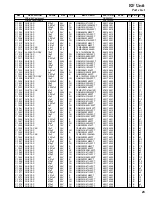
11
Alignment
Introduction
The
VX-2500EV
is carefully aligned at the factory for the
specified performance across the frequency range speci-
fied for each version. Realignment should therefore not
be necessary except in the event of a component failure,
or altering version type. All component replacement and
service should be performed only by an authorized Ver-
tex Standard representative,or the warranty policy may
be void.
The following procedures cover the sometimes critical and
tedious adjustments that are not normally required once
the transceiver has left the factory. However, if damage
occurs and some parts subsequently are placed, realign-
ment may be required. If a sudden problem occurs dur-
ing normal operation, it is likely due to component fail-
ure; realignment should not be done until after the faulty
component has been replaced.
We recommend that servicing be performed only by au-
thorized Vertex Standard service technicians who are ex-
perienced with the circuitry and fully equipped for repair
and alignment. Therefore, if a fault is suspected, contact
the dealer from whom the transceiver was purchased for
instructions regarding repair. Authorized Vertex Standard
service technicians realign all circuits and make complete
performance checks to ensure compliance with factory
specifications after replacing any faulty components.
Those who do undertake any of the following alignments
are cautioned to proceed at their own risk. Problems
caused by unauthorized attempts at realignment are not
covered by the warranty policy. Also, Vertex Standard
reserves the right to change circuits and alignment proce-
dures in the interest of improved performance, without
notifying owners.
Under no circumstances should any alignment be attempt-
ed unless the normal function and operation of the trans-
ceiver are clearly understood, the cause of the malfunc-
tion has been clearly pinpointed and any faulty compo-
nents replaced, and realignment determined to be abso-
lutely necessary.
The following test equipment (and thorough familiarity
with its correct use) is necessary for complete realignment.
Correction of problems caused by misalignment result-
ing from use of improper test equipment is not covered
under the warranty policy. While most steps do not re-
quire all of the equipment listed, the interactions of some
adjustments may require that more complex adjustments
be performed afterwards.
Do not attempt to perform only a single step unless it is
clearly isolated electrically from all other steps. Have all
test equipment ready before beginning, and follow all of
the steps in a section in the order presented.
Required Test Equipment
RF Signal Generator with calibrated output level
at 200MHz
Deviation Meter (linear detector)
In-line Wattmeter with 5% accuracy at 200MHz
50
Ω
RF Dummy Load with power rating 100W
at 200MHz
4
Ω
AF Dummy Load
Regulated DC Power Supply (standard 13.2V
DC, 15A)
Frequency Counter with 0.1ppm accuracy at
200MHz
AC Voltmeter
DC Voltmeter
VHF Sampling Coupler
IBM PC/compatible Computer
Oscilloscope
Vertex Standard
VPL-1
Connection Cable &
Alignment program CE63.
Alignment Preparation & Precautions
A 50
Ω
RF Dummy Load and in-line wattmeter must be
connected to the main antenna jack in all procedures that
call for transmission, except where specified otherwise.
Correct alignment is not possible with an antenna.
After completing one step, read the following step to de-
termine whether the same test equipment will be required.
If not, remove the test equipment (except dummy load
and wattmeter, in connected) before proceeding.
Correct alignment requires that the ambient temperature
be the same as that of the transceiver and test equipment,
and that this temperature be held constant between 20°C
and 30°C (68°~ F86°F). When the transceiver is brought
into the shop from hot or cold air, it should be allowed
time to come to room temperature before alignment.
Whenever possible, alignments should be made with os-
cillator shields and circuit boards firmly affixed in place.
Also, the test equipment must be thoroughly warmed up
before beginning.
Note:
Signal levels in dB referred to in this procedure are
based on
0dB
µ
= 0.5
µ
V (closed circuit).
Setup the test equipment as shown below, apply 13.2V
DC power to the transceiver.
The transceiver must be programmed for use in the in-
tended system before alignment is attempted. The RF pa-
rameters are loaded from the file during the alignment
process.
Transceiver
13.2 VDC
Power Supply
RF Sampling
Coupler
Summary of Contents for VX-2500EV
Page 5: ...5 Block Diagram 1 ...
Page 6: ...6 Block Diagram 2 ...
Page 7: ...7 Interconnection Diagram ...
Page 8: ...8 Note ...
Page 18: ...18 RF Unit Jumper Information Note ...
Page 34: ...PANEL Unit 34 Note ...
Page 43: ...19 ...












































